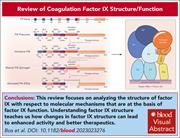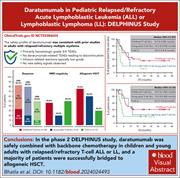Issue Archive
Table of Contents
EDITORIAL
Introduction to a review series on von Willebrand factor, factor VIII, and factor IX
Edited and introduced by Associate Editor Thomas Ortel, this review series features 3 reviews of von Willebrand factor, factor VIII, and factor IX. These 3 proteins are functionally intertwined, and insights into their structure, molecular interactions, and modifications have led to important advancements in therapies for hemophilia A and B and for treatment for thrombotic thrombocytopenic purpura.
BLOOD COMMENTARIES
SPECIAL REPORT
Genetic risk classification for adults with AML receiving less-intensive therapies: the 2024 ELN recommendations
Since European LeukemiaNet (ELN) acute myeloid leukemia (AML) genetic risk classification systems are based on patients treated with intensive chemotherapy, Döhner and colleagues, in this month’s CME article, examine the ability of the systems to predict outcomes in older patients treated with low-intensity therapy. The authors analyzed 279 patients treated with venetoclax-azacitidine and 113 patients treated with placebo-azacitidine, demonstrating that the ELN prognostic criteria discriminate poorly as most patients were classified as adverse risk. They applied a bioinformatic algorithm identifying that a novel prognostic classifier based on TP53, FLT3-ITD, NRAS, and KRAS mutations allows discrimination of 3 risk groups with distinct differences in overall survival. In an accompanying Special Report, Döhner et al codify these observations into a new 2024 ELN genetic risk classification for patients with AML receiving less-intensive therapy.
REVIEW SERIES
How unique structural adaptations support and coordinate the complex function of von Willebrand factor
Edited and introduced by Associate Editor Thomas Ortel, this review series features 3 reviews of von Willebrand factor, factor VIII, and factor IX. These 3 proteins are functionally intertwined, and insights into their structure, molecular interactions, and modifications have led to important advancements in therapies for hemophilia A and B and for treatment for thrombotic thrombocytopenic purpura.
Coagulation factor VIII: biological basis of emerging hemophilia A therapies
Edited and introduced by Associate Editor Thomas Ortel, this review series features 3 reviews of von Willebrand factor, factor VIII, and factor IX. These 3 proteins are functionally intertwined, and insights into their structure, molecular interactions, and modifications have led to important advancements in therapies for hemophilia A and B and for treatment for thrombotic thrombocytopenic purpura.
Blood coagulation factor IX: structural insights impacting hemophilia B therapy
Edited and introduced by Associate Editor Thomas Ortel, this review series features 3 reviews of von Willebrand factor, factor VIII, and factor IX. These 3 proteins are functionally intertwined, and insights into their structure, molecular interactions, and modifications have led to important advancements in therapies for hemophilia A and B and for treatment for thrombotic thrombocytopenic purpura.
CLINICAL TRIALS AND OBSERVATIONS
Genetic risk stratification and outcomes among treatment-naive patients with AML treated with venetoclax and azacitidine
CME
Clinical Trials & Observations
Since European LeukemiaNet (ELN) acute myeloid leukemia (AML) genetic risk classification systems are based on patients treated with intensive chemotherapy, Döhner and colleagues, in this month’s CME article, examine the ability of the systems to predict outcomes in older patients treated with low-intensity therapy. The authors analyzed 279 patients treated with venetoclax-azacitidine and 113 patients treated with placebo-azacitidine, demonstrating that the ELN prognostic criteria discriminate poorly as most patients were classified as adverse risk. They applied a bioinformatic algorithm identifying that a novel prognostic classifier based on TP53, FLT3-ITD, NRAS, and KRAS mutations allows discrimination of 3 risk groups with distinct differences in overall survival. In an accompanying Special Report, Döhner et al codify these observations into a new 2024 ELN genetic risk classification for patients with AML receiving less-intensive therapy.
GENE THERAPY
Genetic engineering of transfusable platelets with mRNA-lipid nanoparticles is compatible with blood banking practices
Strong and colleagues demonstrate in preclinical studies that lipid nanoparticles can transfer mRNA to platelets suspended in plasma and plasma supplemented with platelet additive solution without affecting the functional attributes of the platelets. The ability to transfect platelets in platelet concentrates for transfusion offers the opportunity to use modified platelets with enhanced properties that improve their survival and functionality.
LYMPHOID NEOPLASIA
Daratumumab in pediatric relapsed/refractory acute lymphoblastic leukemia or lymphoblastic lymphoma: the DELPHINUS study
Clinical Trials & Observations
Bhatla and colleagues present results of the DELPHINUS study evaluating daratumumab with chemotherapy in relapsed/refractory (R/R) B-cell acute lymphoblastic leukemia (B-ALL), T-cell ALL (T-ALL), and lymphoblastic lymphoma (LL). Treatment of B-ALL was deemed futile and the cohort closed; however, in T-ALL, daratumumab with chemotherapy yielded excellent results, with overall response rates of over 80% and complete responses of 60% in T-ALL. Though numbers were small, daratumumab is likely to prove effective as a bridge to hematopoietic cell transplant for children and young adults with R/R T-ALL/LL.
THROMBOSIS AND HEMOSTASIS
Whole-genome analysis of plasma fibrinogen reveals population-differentiated genetic regulators with putative liver roles
It is known that plasma fibrinogen levels vary widely and are influenced by genetic polymorphisms, but studies have been focused largely on European populations. Huffman et al performed a meta-analysis of whole genome sequences in 2 large databases encompassing over 160 000 individuals with broad ethnic diversity and identified 18 novel relevant loci not previously identified. Polygenic risk scores based on these and previously identified loci associate with thrombotic and inflammatory phenotypes, providing avenues for further delineation of the connection between coagulation and inflammation.
LETTER TO BLOOD
Genomic analysis of adult thrombotic microangiopathies in less than 3 days: from rapid to fast genomics to treatment
In this Letter to Blood, Yousfi and colleagues describe a rapid genomic nanopore sequencing assay for thrombotic microangiopathies that reduces genetic diagnosis from over 6 weeks to less than 3 days, is cheaper than standard sequencing, and offers opportunities for rapid initiation of complement blockade.
BLOOD WORK
CONTINUING MEDICAL EDUCATION (CME) QUESTIONS
-
Cover Image
Cover Image
![issue cover]()
A transmission electron micrograph of activated human platelets. In contrast, platelets that were genetically modified with mRNA-lipid nanoparticles to express exogenous enzymes had comparable morphology to resting platelets (not shown). See the article by Strong et al on page 2223.
- PDF Icon Front MatterFront Matter
- PDF Icon Table of ContentsTable of Contents
- PDF Icon Editorial BoardEditorial Board
Advertisement intended for health care professionals
Email alerts
Advertisement intended for health care professionals








